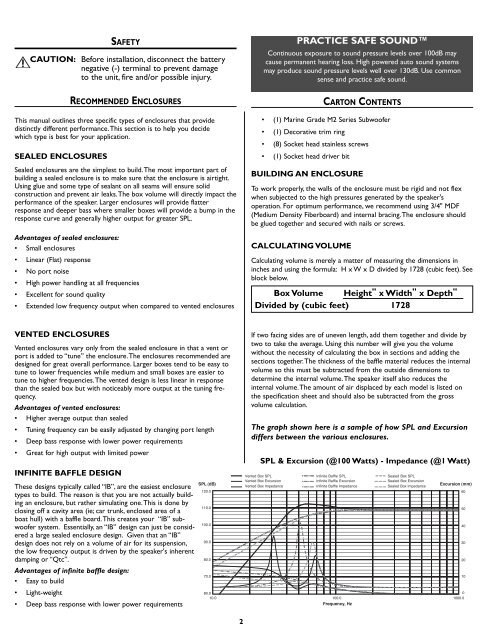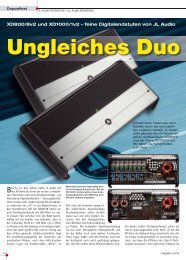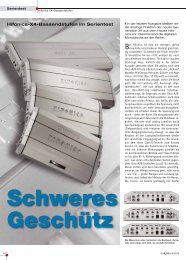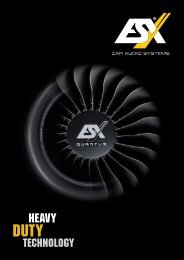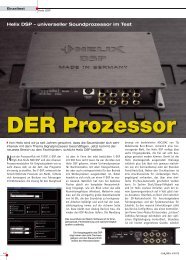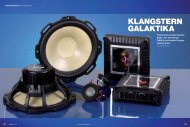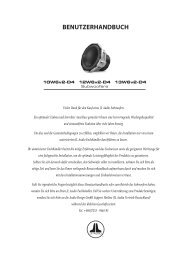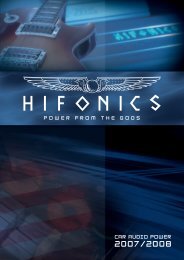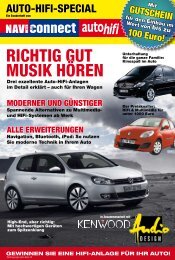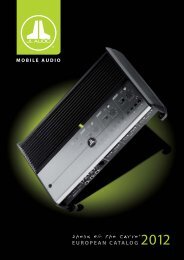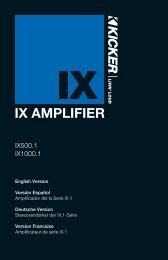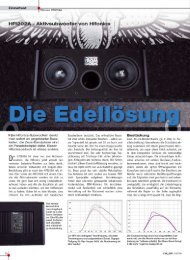SVC - S - Audio Design GmbH
SVC - S - Audio Design GmbH
SVC - S - Audio Design GmbH
You also want an ePaper? Increase the reach of your titles
YUMPU automatically turns print PDFs into web optimized ePapers that Google loves.
SAFETY<br />
CAUTION: Before installation, disconnect the battery<br />
negative (-) terminal to prevent damage<br />
to the unit, fire and/or possible injury.<br />
This manual outlines three specific types of enclosures that provide<br />
distinctly different performance.This section is to help you decide<br />
which type is best for your application.<br />
SEALED ENCLOSURES<br />
RECOMMENDED ENCLOSURES<br />
Sealed enclosures are the simplest to build.The most important part of<br />
building a sealed enclosure is to make sure that the enclosure is airtight.<br />
Using glue and some type of sealant on all seams will ensure solid<br />
construction and prevent air leaks.The box volume will directly impact the<br />
performance of the speaker. Larger enclosures will provide flatter<br />
response and deeper bass where smaller boxes will provide a bump in the<br />
response curve and generally higher output for greater SPL.<br />
Advantages of sealed enclosures:<br />
• Small enclosures<br />
• Linear (Flat) response<br />
• No port noise<br />
• High power handling at all frequencies<br />
• Excellent for sound quality<br />
• Extended low frequency output when compared to vented enclosures<br />
PRACTICE SAFE SOUND<br />
Continuous exposure to sound pressure levels over 100dB may<br />
cause permanent hearing loss. High powered auto sound systems<br />
may produce sound pressure levels well over 130dB. Use common<br />
sense and practice safe sound.<br />
BUILDING AN ENCLOSURE<br />
To work properly, the walls of the enclosure must be rigid and not flex<br />
when subjected to the high pressures generated by the speaker's<br />
operation. For optimum performance, we recommend using 3/4" MDF<br />
(Medium Density Fiberboard) and internal bracing.The enclosure should<br />
be glued together and secured with nails or screws.<br />
CALCULATING VOLUME<br />
CARTON CONTENTS<br />
• (1) Marine Grade M2 Series Subwoofer<br />
• (1) Decorative trim ring<br />
• (8) Socket head stainless screws<br />
• (1) Socket head driver bit<br />
Calculating volume is merely a matter of measuring the dimensions in<br />
inches and using the formula: H x W x D divided by 1728 (cubic feet). See<br />
block below.<br />
Box Volume Height" x Width" x Depth"<br />
Divided by (cubic feet) 1728<br />
VENTED ENCLOSURES<br />
Vented enclosures vary only from the sealed enclosure in that a vent or<br />
port is added to “tune” the enclosure.The enclosures recommended are<br />
designed for great overall performance. Larger boxes tend to be easy to<br />
tune to lower frequencies while medium and small boxes are easier to<br />
tune to higher frequencies.The vented design is less linear in response<br />
than the sealed box but with noticeably more output at the tuning frequency.<br />
Advantages of vented enclosures:<br />
• Higher average output than sealed<br />
• Tuning frequency can be easily adjusted by changing port length<br />
• Deep bass response with lower power requirements<br />
• Great for high output with limited power<br />
INFINITE BAFFLE DESIGN<br />
These designs typically called “IB”, are the easiest enclosure<br />
types to build. The reason is that you are not actually building<br />
an enclosure, but rather simulating one.This is done by<br />
closing off a cavity area (ie; car trunk, enclosed area of a<br />
boat hull) with a baffle board.This creates your “IB” subwoofer<br />
system. Essentially, an “IB” design can just be considered<br />
a large sealed enclosure design. Given that an “IB”<br />
design does not rely on a volume of air for its suspension,<br />
the low frequency output is driven by the speaker's inherent<br />
damping or “Qtc”.<br />
Advantages of infinite baffle design:<br />
• Easy to build<br />
• Light-weight<br />
• Deep bass response with lower power requirements<br />
If two facing sides are of uneven length, add them together and divide by<br />
two to take the average. Using this number will give you the volume<br />
without the necessity of calculating the box in sections and adding the<br />
sections together.The thickness of the baffle material reduces the internal<br />
volume so this must be subtracted from the outside dimensions to<br />
determine the internal volume.The speaker itself also reduces the<br />
internal volume.The amount of air displaced by each model is listed on<br />
the specification sheet and should also be subtracted from the gross<br />
volume calculation.<br />
The graph shown here is a sample of how SPL and Excursion<br />
differs between the various enclosures.<br />
SPL & Excursion (@100 Watts) - Impedance (@1 Watt)<br />
2


